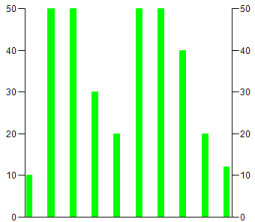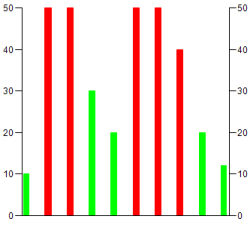Tutorial: Displaying Array Data in a Histogram
Setting element properties for the histogram
A project contains a visualization object and a program.
A one-dimensional array is declared in the program (example:
histogram : ARRAY[1..10] OF INT;).In the program, data is assigned to the
histogramarray (example: within the range from0to50).
In the device tree, double-click the visualization object.
In the Visualization Toolbox view, click Measurement Controls and drag the Histogram element to the visualization editor.
In the visualization editor, click the inserted histogram.
The Properties view opens.
In the Properties view, in the Data array element property, double-click in the Value input field and click
 .
.In the Input Assistant dialog in the Variables category of the PLC_PRG program, select the array (example here:
histogram : ARRAY[1..10] OF INT;) and click OK.To display only part of the array as a histogram, activate the Use subrange option and specify the index values of the array in Start index and End index to define the subrange.
Select the Display type (example: Bar).
Specify a value between
1and100(example:30) for the Relative bar width.Click the histogram in the visualization editor and change the size and position as desired.
The Position property changes its values accordingly.
Specify the values for the Scale element property. Select the values for Scale start and Scale end so that the array is displayed completely. For the example: Scale start
0, Scale end50.For the distance between values on the main scale, specify the value
10, for example, in Main scale.In the Label element property, specify the Unit for the display values.
Click the Build → Generate Code command.
If the project has been compiled without errors, then click the Online → Login command and then click the Debug → Start command to start the application.
The histogram is displayed in the visualization as follows:

For more information, see the following: Element: Histogram
Defining alarm colors for the histogram
The visualization displays a histogram with bars all the same color (example: green). Now you want the bars with values less than 30, for example, to be displayed in another color (example: red).
Select the Colors → Alarm color element property.
Specify the limiting value in Alarm value above or below which the bars should be displayed in another color.
Select More from the list box in Alarm condition if all values greater than the Alarm value should be displayed in another color. Otherwise, select Less.
Select an Alarm color (example: Red).
Click the Build → Generate Code command.
If the project has been compiled without errors, then click the command and then click the Debug → Start command to start the application.
In the example histogram, all bars with values greater than
30are displayed in red.